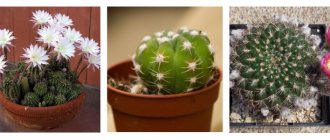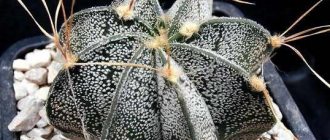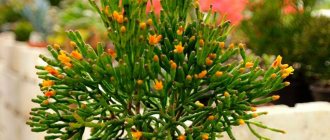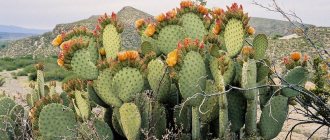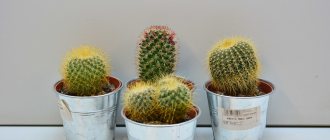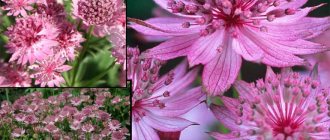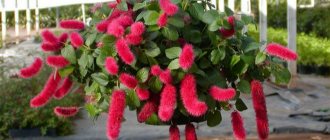Echinopsis is the most common genus of cacti and probably the easiest to care for. These plants do not attract much attention until they begin to bloom. Flowering, unfortunately, is short-lived (1-3 days, depending on air temperature), but very impressive. You look at a huge flower that appeared literally overnight, and you involuntarily exclaim: “Who would have thought!” So much for the inconspicuous echinopsis.
First, fluffy lumps form on the surface of the stems (usually on the shady side), which then quickly stretch into a tube that opens into a gramophone-shaped flower. Old specimens of Echinopsis can produce more than 25 flowers at a time.
Echinopsis acute. © Alan Levine
Echinopsis is a genus of plants in the Cactus family, which includes about 150 species.
The flowers of this plant are funnel-shaped, 20-25 cm long, white, less often pink or red. It begins to bloom at the age of 3. By the way, echinos is translated from Greek as “hedgehog”, because this plant really resembles a hedgehog both in shape and with its spines.
Features of the genus
Translated from Greek, its name means hedgehog .
At the beginning of development, these cacti really look like prickly hedgehogs curled up into a ball. Echinopsis have fleshy stems and a powerful root system. The roots are located close to the surface. Their flowers are very large, located on a long, pubescent stalk. Some have a pleasant aroma.
Different species bloom from early spring to late autumn. Each flower lives in bloom for only a day or two.
The number of flowers on a plant reaches 20-25 pieces . They produce a red or yellowish fruit in the shape of a ribbed barrel or ball.
They grow very quickly, the first flowers appear at the age of 3 years . Varietal varieties grow more slowly.
Choosing a place for a cactus
Often, inexperienced owners place a pot of cactus near the computer or on a bookshelf, believing that this picky plant can grow in the shade. Over time, the flowerpot turns yellow and the needles begin to fall off. In order to avoid these unpleasant consequences, you need to figure out what type of cactus your pet belongs to.
Cactus is a picky plant that can decorate any interior.
South window sills
Desert cacti are sun lovers. This species is able to survive in the most extreme conditions due to its thickened root system. The ribbed surface ensures minimal evaporation of moisture, which explains the pickiness in terms of watering.
Most house cacti love sunlight, but direct rays should be avoided. This plant can be kept in open areas for no more than 6 hours. It is advisable to hang a tulle or curtain on the window, which will protect the prickly pet. Leaf cacti and epiphytes cannot tolerate the scorching sun at all. This type of cactus should be in the sun for no more than 4 hours.
East and north windows
The north or east side is the most optimal for the growth of cacti. Sometimes on the south side the plant gets burned under the influence of direct sunlight, so you need to create light partial shade. It all depends on the climate: those who live in a country with a hot climate choose the north or east side, and those who live in cold countries choose the south.
Important! Only 70% of these plants can tolerate direct sun exposure. Even this category gets burned when exposed to the sun for a long time: the top layer turns red or turns black
Burns do not harm the plant, but it is still advisable to choose a northern window sill and sometimes take the cactus to the balcony.
Kinds:
- Eyrieza Dark green Echinopsis, spherical in young specimens and short-cylindrical in adult specimens.
Height 20-22 cm, diameter about 15 cm.Areoles are white-yellow, round. The spines are long. The flowers are elongated, white-pink.
- Chilean Tree-like, branches at the base. The stem is cylindrical, elongated. Ribs with pronounced tubercles, low. Pale yellow, one to two centimeters long. The central spine is 4-7 cm . The flowers are large, about 14 centimeters in length.
- Pampana The stem is spherical, 5-7 centimeters in diameter. The spines are curved, up to 5 centimeters long . The flowers are red.
- Shilya
The height of the stem is 5-6 centimeters. About 14 ribs .
The areoles and spines are white. The flowers are fiery red and erect. - Klinger Stem spherical at the top, cylindrical at the base.
The spines are long, grayish, located on light, pubescent areoles. Flowers with multi-tiered petals, snow-white with dark tips. - Dumat The stem is low-growing, rounded, with pronounced ribs. The spines are small. The flowers are lilac-white.
- Sharp-edged , spherical, somewhat elongated stem, diameter 20-25 cm , length 15 cm. Covered with pointed ribs with large areoles. The flowers are lilac-red. Blooms at night, in May-June.
- Mammillosa kermesina Exquisite form of the Echinopsis cactus, single stem, about 30 centimeters . The areoles are round with yellow awl-shaped spines. Pink flowers grow in tiers.
- Tubeflower Green, initially spherical, then cylindrical-shaped stem. The spines are brown, black at the tips. It blooms with large, funnel-shaped, white flowers on a twenty-centimeter stalk.
- Ancistropha Green small stem in the shape of a flattened ball. Covered with pronounced tubercles and hook-shaped spines. The flowers are white.
- Subdenudata
It differs from other species in the absence of spines. A spherical, flattened stem 20 cm high and 10 cm in diameter .
Flowers are 10 cm. Blooms at a young age. - Golden Stem is spherical at the beginning of growth and cylindrical in adults.
Pronounced ribs covered with centimeter-long spines. The flower is yellow-orange. Withstands light frosts. - Backeberg Round-cylindrical stems, height up to 7 centimeters. The flowers are bright pink.
- Bridges Grows in groups of 4 to 6 trunks. Tall, about 40 centimeters , stems with a diameter of 10-13 centimeters. The flowers are white.
- Chamecerus Forms numerous stems hanging over the edge of the pot. Blooms in spring with bright orange flowers. Frost-resistant.
- Bright green Echinopsis Globular stem with a diameter of about 9 centimeters . Sparse radial, numerous central spines.
- Coquimban Cylindrical, elongated stem. In nature it grows up to one meter. Forms dense thickets.
Possible difficulties during cultivation
Echinopsis is resistant to diseases and pests. But if care is not taken care of, they can get sick, and pests can also appear.
Did you know? Disinfected cactus needles were used in the past in Latin America by doctors to stitch wounds.
Drafts, waterlogging, cold air temperatures - all this can cause the following diseases:
Black rot. Dark black-brown spots appear on the plant. To fight, carefully cut out all the spots, and sprinkle the cut areas with sulfur. Spray with “Hom”, “Fundazol”, “Oxychom”.
Dry rot. A sign of its appearance is the drying and wilting of the cactus. It is better to prevent the disease, as it cannot be cured. To do this, treat with a systemic fungicide (“Fundazol”) approximately once every few months.
Spotting. It occurs in the form of rusty spots and stains. May be a consequence of sunburn due to direct sunlight on the cactus, as well as exposure to cold water. To prevent the disease from spreading, the cactus is sprayed with fungicides (systemic drug “Topaz”).
Anthroclosis (brown spotting). It appears as spots ranging from light to dark in color. The area of the stains is dry and depressed
To combat, carefully cut off the affected areas and sprinkle with activated carbon powder. Then fungicides are used (Fundazol, Maxim).
Brown rot
When it appears, the stem darkens and the cactus becomes soft to the touch. It cannot be treated; it is better to dispose of the affected specimen.
Yellowing. The cause may be a lack of nutrients in the soil. Mineral fertilizers are used.
Echinopsis is susceptible to attacks by the following pests:
- Spider mite. Identified by brown spots and the appearance of the finest cobwebs. The stem is cleaned and sprayed with chemicals (“Aktara”, “Aktellik”, “Fitoverm”).
- Mealybug. The insect is about 5 mm. It is revealed in the form of a white cotton-like coating, which is cleaned off with a sponge dipped in a soap solution. Then chemical agents are used (“Aktara”, “Aktofit”).
- Cactus nematodes. Small worms about 1 mm. Infection occurs through the soil or from other diseased plants. Nematodes primarily attack roots. Signs of appearance: growth slows down and the stem withers. To combat, the plant is heated to +52…+55°C for 15–18 minutes. Then the affected roots are removed, the cactus is dried for 3 days, and then transplanted into new soil and temporarily quarantined, away from other indoor flowers.
Did you know? Some species of Echinopsis are powerful hallucinogens. For example, Echinopsis pachano, called the San Pedro cactus, has been used in folk medicine and shamanic rituals of Indians in Latin America for 3 thousand years.
For lovers of flowering cacti, Echinopsis is an excellent choice. It is beautiful, especially during the flowering period, and unpretentious.
Photo
Below are photos of a cactus of the Echinopsis species
Rhipsalis
In the wild it grows on trees or steep cliffs in the forests of India and South America. Its main distinguishing feature is its very long stems. Interestingly, depending on the type of cactus, they can be of different shapes: ribbed, rounded, leaf-shaped. The color also varies from light green to dark green. Most subspecies of rhipsalis do not have thorns, so it certainly will not harm the household. The stems branch abundantly, beautifully falling from the pot. The shoots have aerial roots, thanks to which they are able to absorb moisture from the air. Delicate flowers are formed in numerous areoles and are usually pink, yellow or scarlet in color. Later, in place of the buds, bright fruits in the form of berries with black seeds are formed. Propagating the plant is quite simple: just cut a cutting, place it in a solution of water with a growth enhancer for several days and root the seedling in a special substrate for succulents.
Rhipsalis cactus has long stems and is perfect for hanging.
Home care
Echinopsis can be freely purchased in the store. When purchasing, inspect it; there should be no signs of rot or pest damage.
After purchase, they are transplanted into a pot, the diameter of which is 1 centimeter larger than the store-bought one . The soil for planting is ready for succulents .
Lighting and temperature
Echinopsis love light, choose the brightest place in the apartment for them. They thrive in direct sunlight. But they need to be accustomed to this gradually to avoid burns.
Growing temperature is from 22 to 27 degrees . In summer, it is advisable to take it out onto the balcony, because there it is possible to reduce the night temperature. The difference between day and night temperatures is favorable for development.
During the autumn cooling, the temperature is gradually increased to 10-12 degrees. Some echinopsis are frost-resistant and can tolerate temperatures down to sub-zero levels.
Humidity and watering
This species tolerates dry air and low humidity.
Watering in summer is plentiful. In autumn, the amount of moisture is gradually reduced, and in November it is stopped. Resume only after a period of rest. In winter they are kept in a cold room; the moisture reserve in the powerful stem lasts until spring.
The frequency of watering and the amount of liquid depends on age. Young small specimens are watered often, adults much less often.
But in any case, the golden rule applies: it is better not to drink too much than to drink too much .
Soil and transplantation rules
This species requires a substrate with a high content of gravel and sand. You can use a store-bought one designed for succulents. You can add humus.
Transplantation is carried out at the end of winter (February) . But not often. Usually this is done through the season, from dry soil to dry soil, and do not water after the procedure for 7-10 days .
There must be drainage in the container. The container for transplantation is taken slightly larger than the previous one.
IMPORTANT . Do not plant echinopsis in a container that is too large and deep - it will not bloom. The pot should be such that there is little space for roots to grow and at the same time cramped.
Top dressing
Echinopsis are fertilized monthly during the growth and flowering period. Use special cactus fertilizer. Make sure that there is no excess nitrogen in the fertilizing, as this can cause the roots to rot.
IMPORTANT . Do not overfeed Echinopsis. It will begin to produce excessive production of children, and there will be no energy left for flowering.
Trimming
Actually, the process of removing babies cannot be called pruning. Excess shoots are simply removed from Echinopsis.
If you allow excessive shoots to form, it will not bloom.
Real pruning is carried out with an elongated corked base. In January, long before the growing season, you need to cut off the brown narrowed part of the stem with a sharp knife and sharpen it slightly.
We place the cut stem on the edge of the pot to dry. We keep it for about seven days, then place it in a bowl of water so that the cut does not reach the surface of the liquid a little.
To do this, use a cardboard stand with a hole in the middle the size of the base of the stem. After a while the roots will appear.
As soon as this happens, we plant the workpiece in the prepared slightly moist soil substrate. Do not rush to water immediately; this can only be done when the sprout takes root.
Maintenance in winter
In winter, cacti have a dormant period. At this time, you need to keep them at a temperature no higher than 10 degrees .
It is a mistake to install Echinopsis in a dark place for the winter.
With a lack of light, it will stretch out and lose its normal shape. If there are no conditions for cold wintering, place it on the windowsill and separate it from the heat with a protective screen.
One way to ensure low temperatures is to use a square aquarium. It is placed on its side, a pot is placed in it and the open side is moved towards the window. This way, your Echinopsis is in the cold, and at the same time has access to light.
During the dormant period, an adult plant is not watered; young, small specimens can be moistened, but no more than twice during the entire period.
Your pet will tell you when to resume watering by the greening of the top of its head.
Reproduction
The easiest way is reproduction by children . They are abundantly overgrown with adult specimens.
The children are separated by unscrewing and placed, slightly buried in the soil.
They take root quickly. Before planting, they are dried for 6-7 days. It is recommended to plant in a mixture of leaf soil and sand. You can add peat to it to improve aeration properties.
The seed method is a chance to get a specimen with brighter colors than the mother one.
The seeds are pre-soaked in warm water. For sowing, take a flat, shallow dish. The first layer is drainage, then a layer of soil. The surface is lightly pressed down, but not too much, to prevent stagnation of moisture.
Distribute the seeds over the surface and sprinkle them with sand. Then moisten with a spray bottle. The crops are covered with glass or film and placed in a damp, dark place until germination. The dishes are regularly aired, but not allowed to dry out.
When seedlings appear, place them in a bright, warm place and grow them as usual. It is advisable to pick when the seedlings reach the size of a large pea.
Reproduction of Echinopsis
Echinopsis reproduces from seeds or by lateral sprouts - “cacti”. The seed method is better because more beautiful plants with bright flowers grow from the seeds. To do this, the seeds are placed in a pot and sprinkled with a thin layer of soil. Keep in a dark, damp room until shoots appear.
When propagated by sprouts, the plant will be identical to the mother. The children are separated with a sharp knife, the cut is allowed to dry, and after a week they are planted in a pot. If the children already have roots, they are planted immediately.
The substrate for planting should be light; it can be prepared from sand and leaf soil. The following soil mixture is also suitable: 2 parts turf soil - 1 part leaf soil, peat soil, humus, sand. Drainage is required.
Echinopsis. © Maja Dumat
Echinopsis. © Maja Dumat
Echinopsis. © Maja Dumat
Diseases and pests
Echinopsis is almost not susceptible . The main problem is rotting of the roots or base of the stem due to improper watering.
Sometimes inexperienced cactus growers mistake the brown base of the stem for a disease. Don't be afraid.
This is not a disease, but an age-related suberization that is natural for an adult plant. If you don't like this look, you can bury the brown part.
The main pests of Echinopsis are scale insects and spider mites .
The presence of spider mites can be seen by the white coating on the stem. Scale insects appear in the form of brown spots. Washing with soapy water and spraying with fungicides helps combat them.
Mealybugs can also harm Echinopsis. These whitish insects settle on the stems and suck the juices from them. It is removed mechanically with a brush dipped in an alcohol solution. Then they are treated with poison.
Scale insects can also settle in the root system . The plant withers away, does not form shoots and does not bloom .
If you notice this, remove it from the pot. Shake off the soil and wash the roots in a solution of potassium permanganate. Plant in a new pot. Treat the stem with insecticides.
general information
Echinopsis (echinopsis) is a genus of succulents belonging to the Cactus family. Its name comes from the Greek “echinus” - hedgehog and “opsis” - similar. This name, which was proposed back in the 30s of the 18th century by Carl Linnaeus, is very suitable for the plants, since, due to the abundance of spines and spherical shape, they really look like hedgehogs curled up into balls.
The range of Echinopsis extends to the territory from Northern Bolivia to Southern Argentina. They are also found in the flora of Uruguay and Southern Brazil. They grow in the Andes, in the valleys and outskirts of mountain ranges.
Echinopsis have gained immense popularity in indoor floriculture. In European countries they have been grown approximately since the late 16th - early 17th centuries. Representatives of the genus have been involved in cultural selection since 1837, and today it has been possible to obtain a large number of hybrid forms that differ in color.
Echinopsis hybrids are also common among gardeners, like zygocacti. At the same time, they not only do not lose popularity, but also continue to be of interest to both cactus growers and breeders.
How a cactus blooms: signs, description of the structure of the flower and fruit
Cactus flowers are solitary, in most cases located at the top of the stem, one in the areola. They have a variety of colors, with the exception of blue. The structure of a cactus flower includes numerous stamens and a stigma. In some species they may differ in color, for example, the yellow stamens and green stigma of the Echinocereus. Flowers appear on both old and young areoles.
There are species of cacti in which flowers develop on a special organ - cephalium (genus Melocactus, Discocactus), formed at the top of the stem. Cephaly is an accumulation of a large amount of fluff, hairs and bristles in the flowering zone. It increases annually, reaching a height of 1 m in some species. Flowers can also develop on the lateral pseudocephaly, for example, in cacti of the genus Cephalocereus, Pilosocereus, etc. The size of cactus flowers varies from small to huge, with a length and diameter of 25-30 cm (genus Selenicereus ). The flowers of some species have a scent (the genus Echinopsis, some species of the genus Dolichothele, etc.). Flowering occurs during the day and at night. Most cacti bloom during the day in the morning or afternoon. Most often, cactus flowers are bisexual and cross-pollinated. In the homeland of cacti, in addition to the wind, insects and birds, including hummingbirds, participate in pollination.
After flowering, berry-shaped juicy, less often dry, fruits are formed. In many species they are edible. The fruit sizes range from 2-3 mm to 10 cm. The largest fruits are found in prickly pears. The fruits may ripen in the current season or the following year (genus Mammillaria). A ripe berry can contain from several to hundreds or more seeds. Some of the smallest seeds are found in Blossfeldia, Strombocactus and Parodies. Large prickly pear seeds have a hard and durable shell. In other cacti, the seed coat is thin and fragile. The germination of seeds of most species lasts up to a year or more; in cereus and mammillaria, up to 7-9 years. Roseocactus fissuratus has a known case of seed germination after 30 years.
How to care?
A lot depends on care at home, including how long and intensively the cactus will bloom. When growing this species, it is necessary to organize high-quality drainage. The soil should be thoroughly watered until water flows through the holes of the pot, then allow the soil to dry thoroughly before moistening it again. In winter, reduce the amount of moisture in the soil. During this period, the plant looks wrinkled, and the stems may take on a reddish tint. There is nothing wrong with such a transformation - soon the cactus will return to its normal appearance again, and this will happen in the spring.
The flower grows well in hanging baskets or small (10 cm) containers, since the root system does not develop deep into the ground. A hybrid may require a larger pot. It is quite difficult to replant old shoots because they easily fall apart. It is necessary to fertilize the flower once a year during the growing season, using a balanced mixture of minerals, preferably organic. In areas where bright sun and heat prevail most of the time, the cactus should be grown in the shade, and where the summer is cool, it is better to choose a sunnier place.
Top dressing
When it comes to fertilizing, it is best to apply it in the spring and summer (during active growth). Cacti are plants that do not grow very quickly, so there is no point in using fertilizer more than a couple of times a year. It is better to choose an organic mixture that will decompose for a long time.
Watering
There is no better plant in nature that would be so well adapted to periods of prolonged drought than cacti. And the described species is no exception in this case. Even if the grower leaves for a while, the flower will not die with dry soil and will feel great for several weeks.
However, at this moment the plant is concerned about how to survive, but not bloom, so without timely and high-quality watering, you can’t even dream of flowers. Give less moisture if the flower is in a colder or shady place.
general description
Cacti are a favorite plant of many gardeners, but not many know what the hairy cactus is called and that it even exists. Such a plant is unpretentious in care; it can easily exist in the home of a person who often forgets about watering.
Fluffy cacti
Thanks to the white cloud of hairs, the plant is protected from the scorching rays of sunlight and various pests. The appearance of the succulent makes it stand out from its nondescript counterparts.
Interesting information! One of the first to study this type of succulents was Esposto Nicholas, after whom the fluffy cactus was named.
What does a fluffy cactus look like?
Often Espostoa can be confused with Cephalocereus. This is also a small genus of cacti, including several species of plants, but they branch at the roots and have long and thick light spines, which are much tougher than those of their furry counterpart.
The fluffy cactus has a columnar structure, sometimes with branching stems, which in appearance may resemble a candelabra. The trunk and shoots have a green or gray tint, some types are darker. The plant is completely covered with long white hairs, which grow most abundantly at the top.
Espostoa
Radial spines have a light yellow or red color, usually their length does not exceed 1 cm. The central spines are much longer (can reach 4 cm), differ in color depending on the species.
